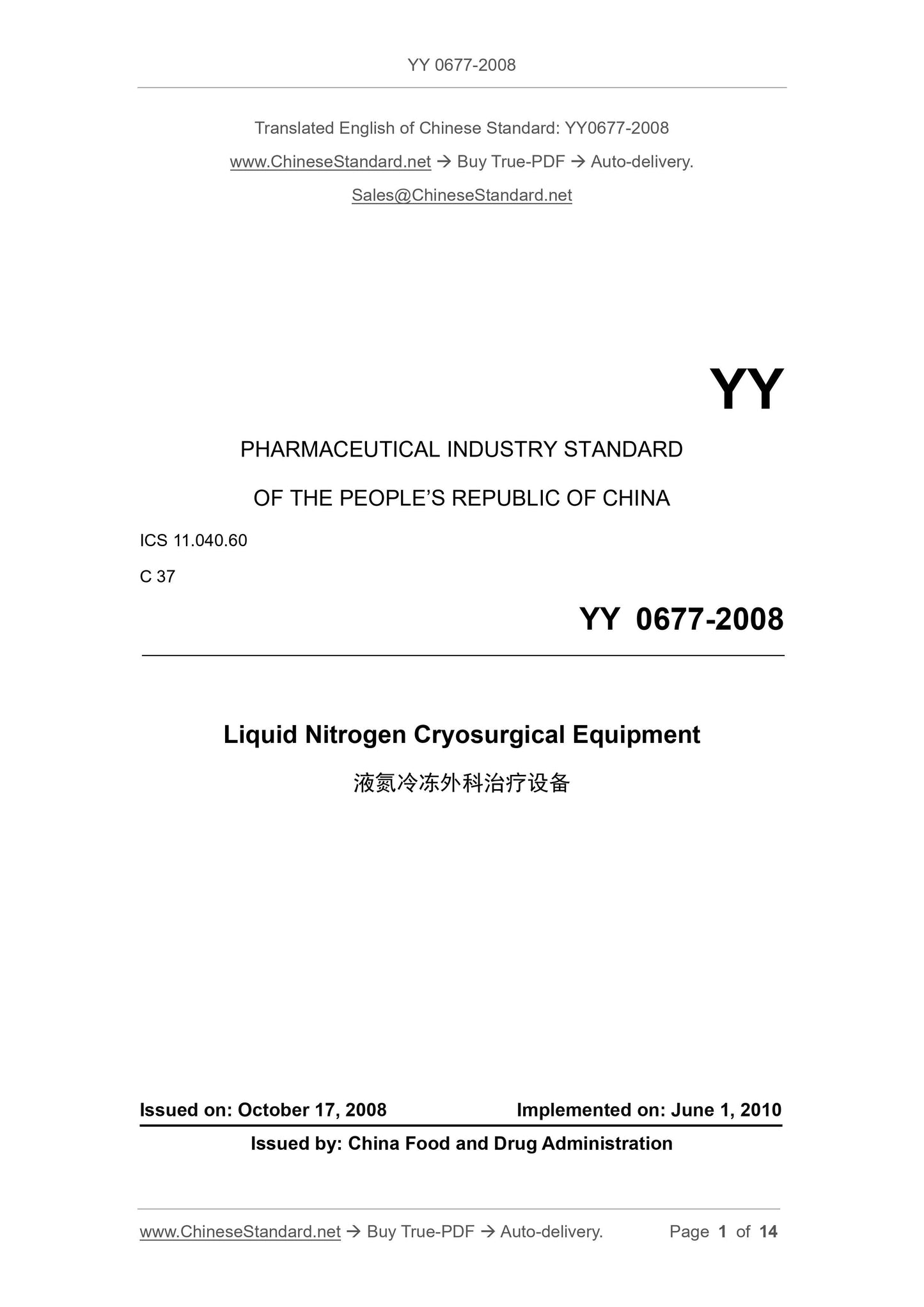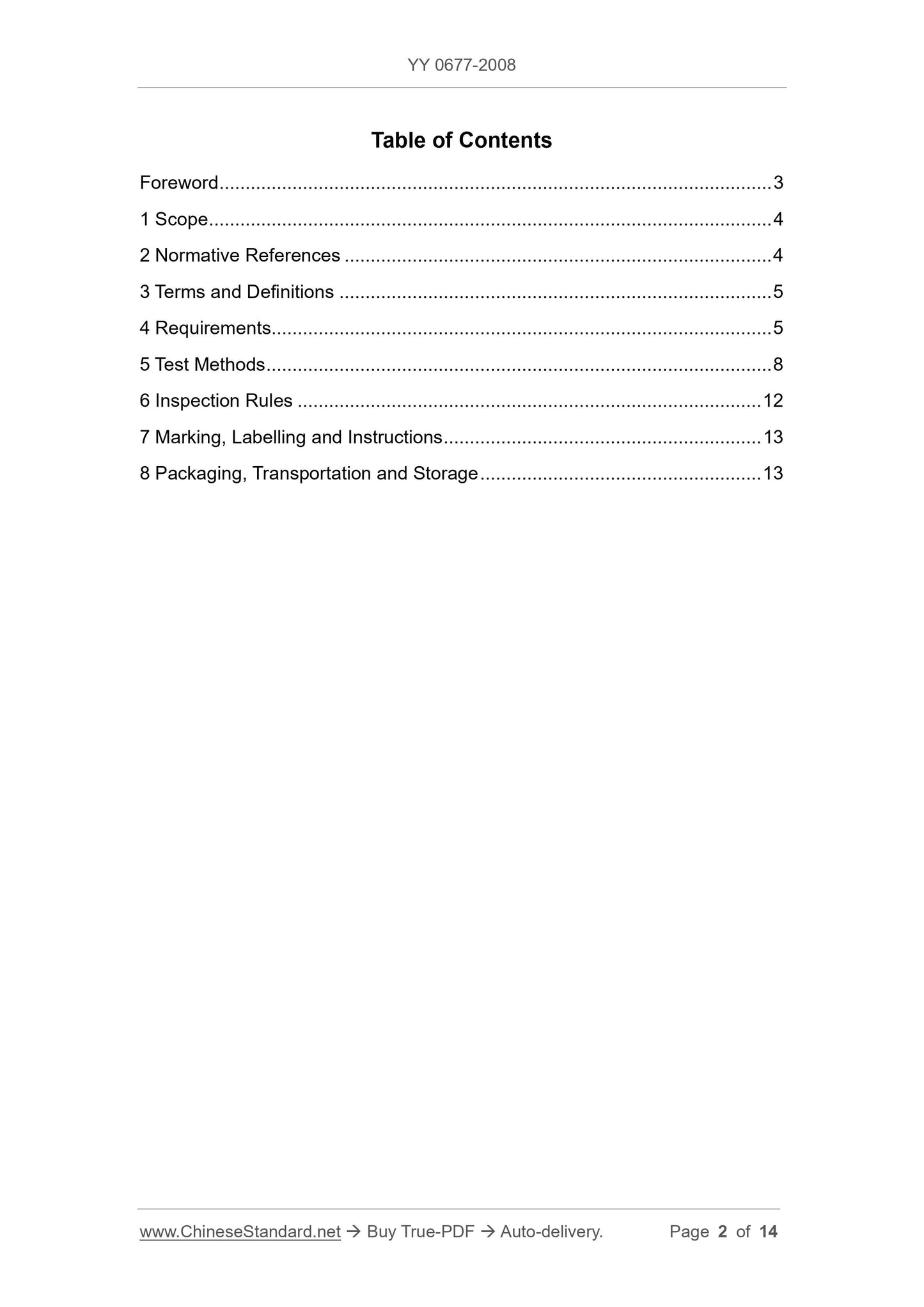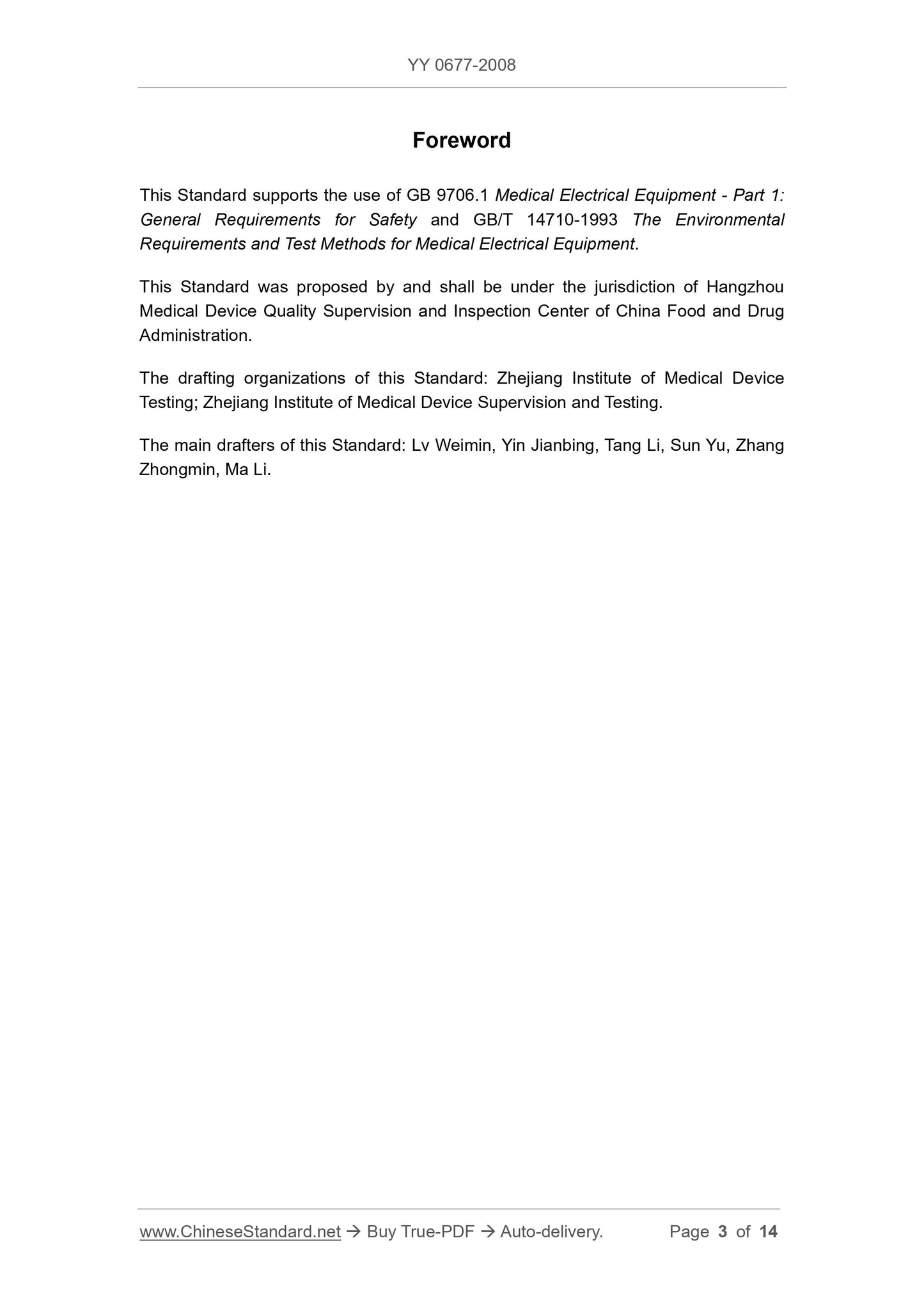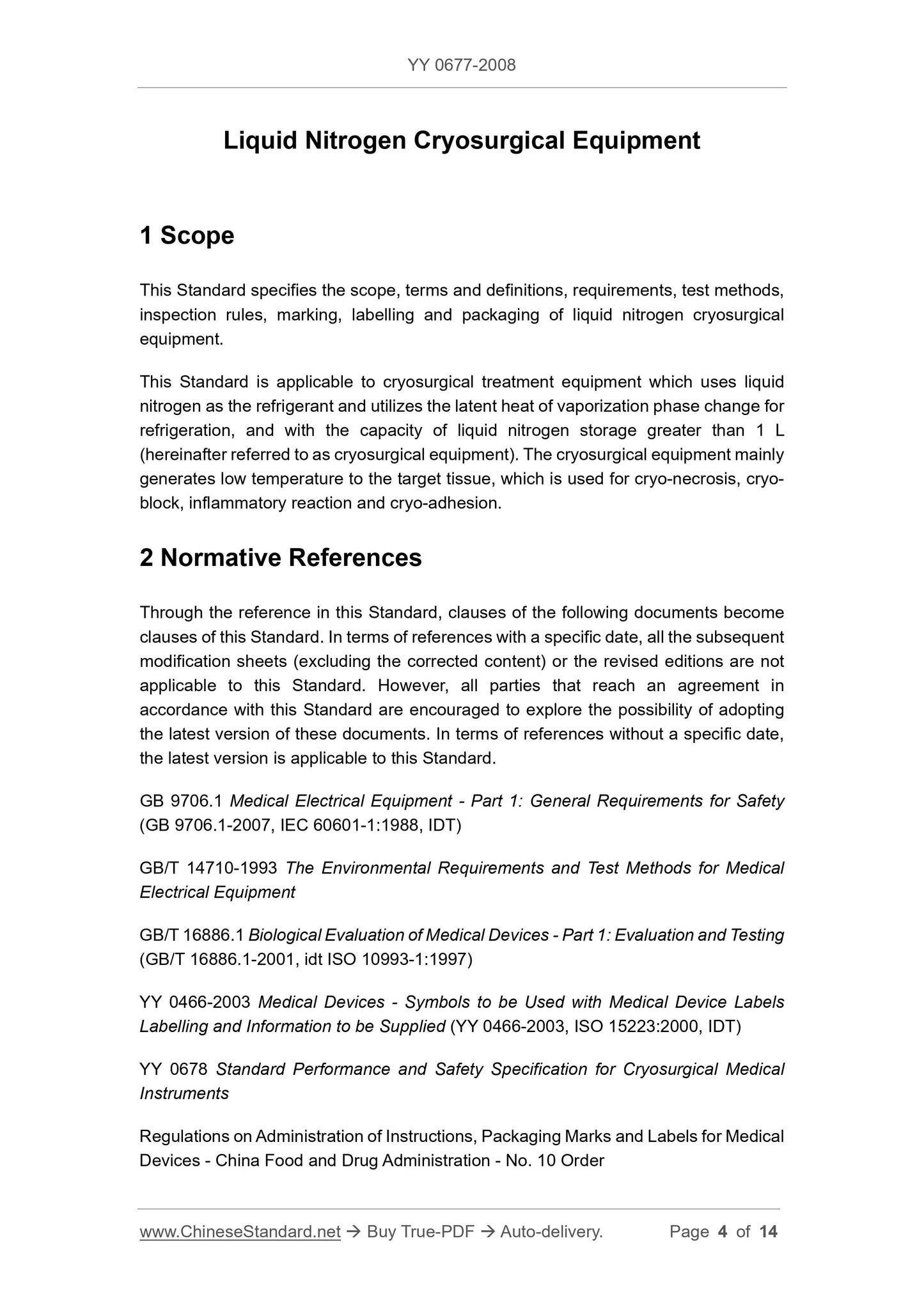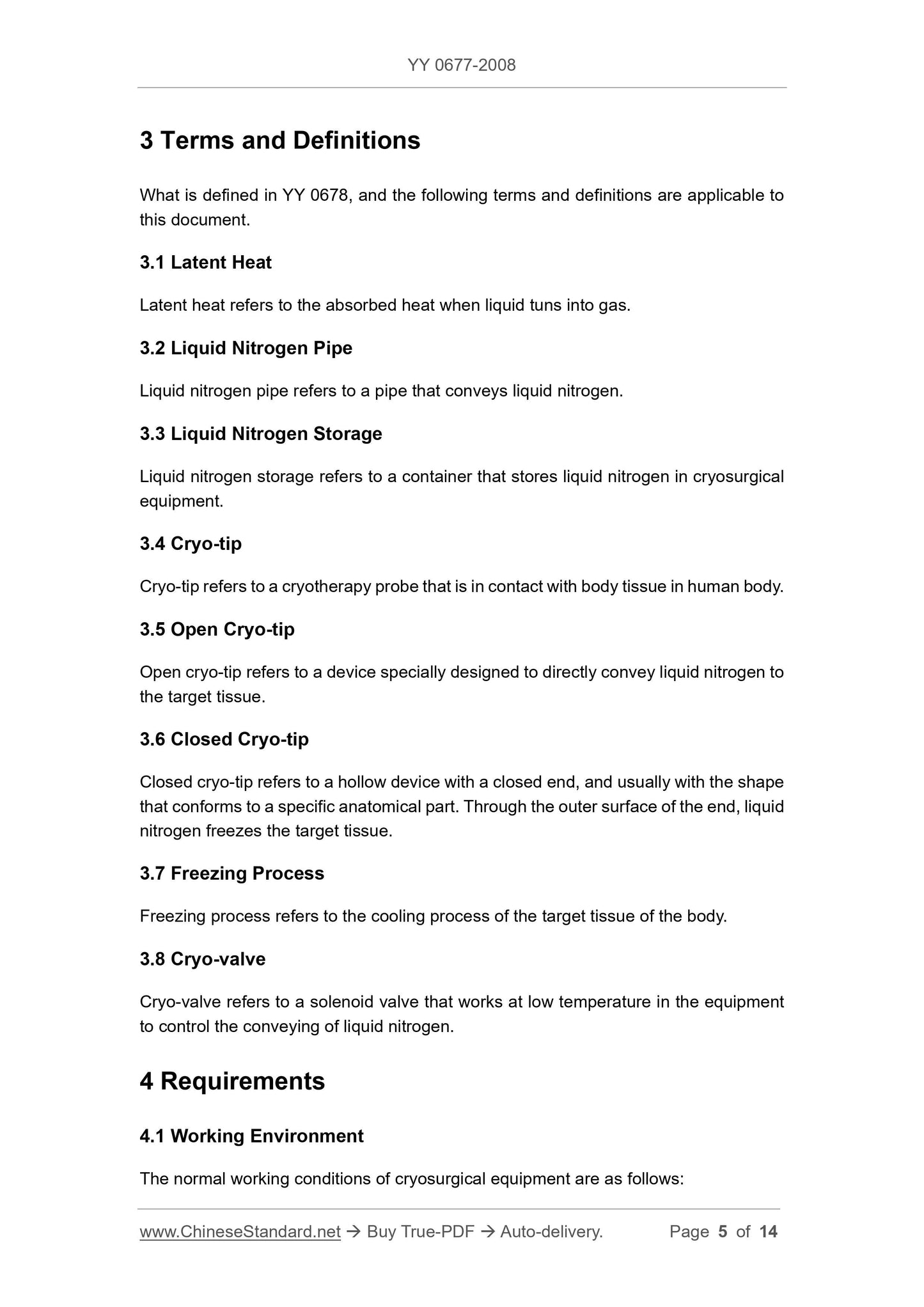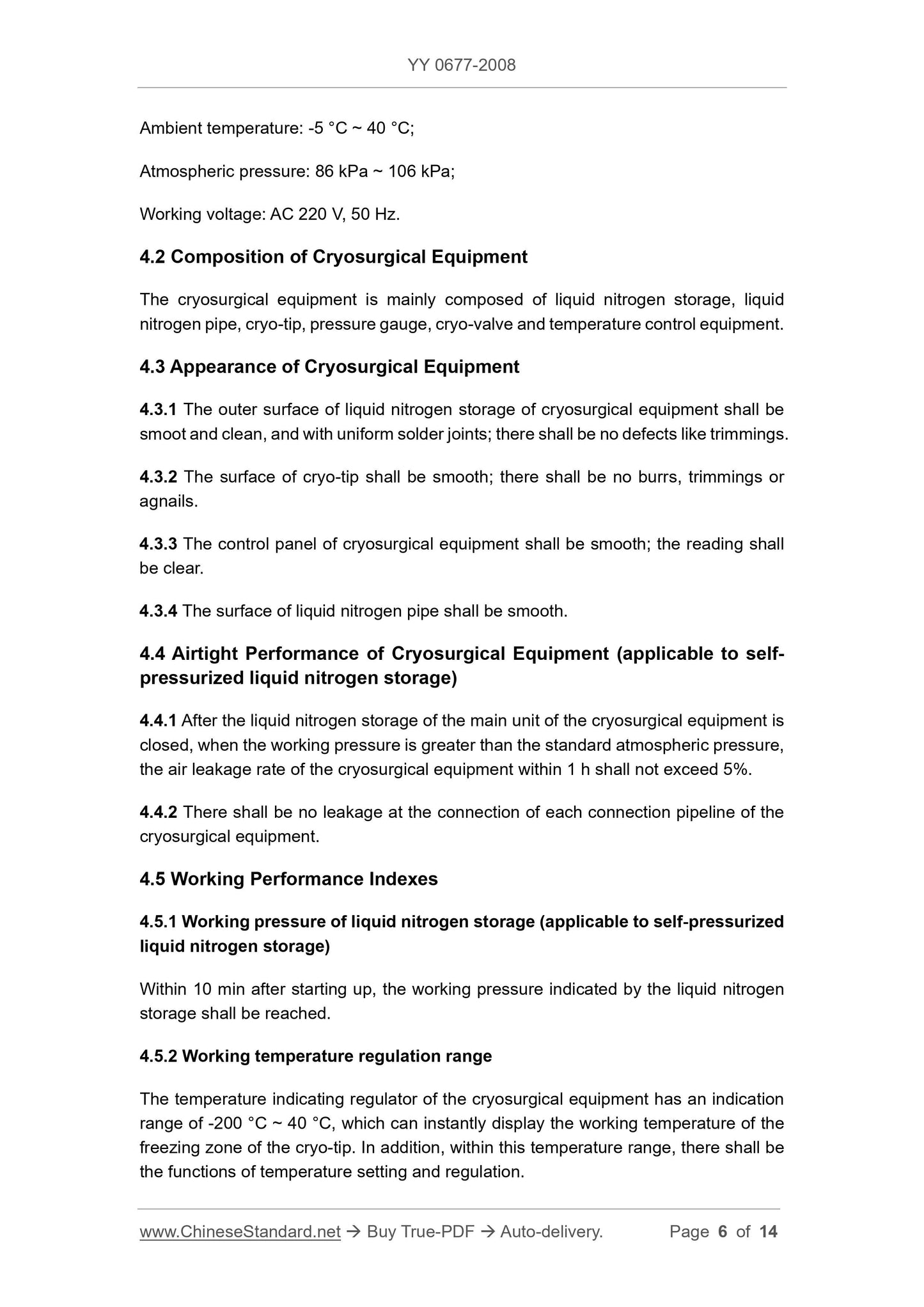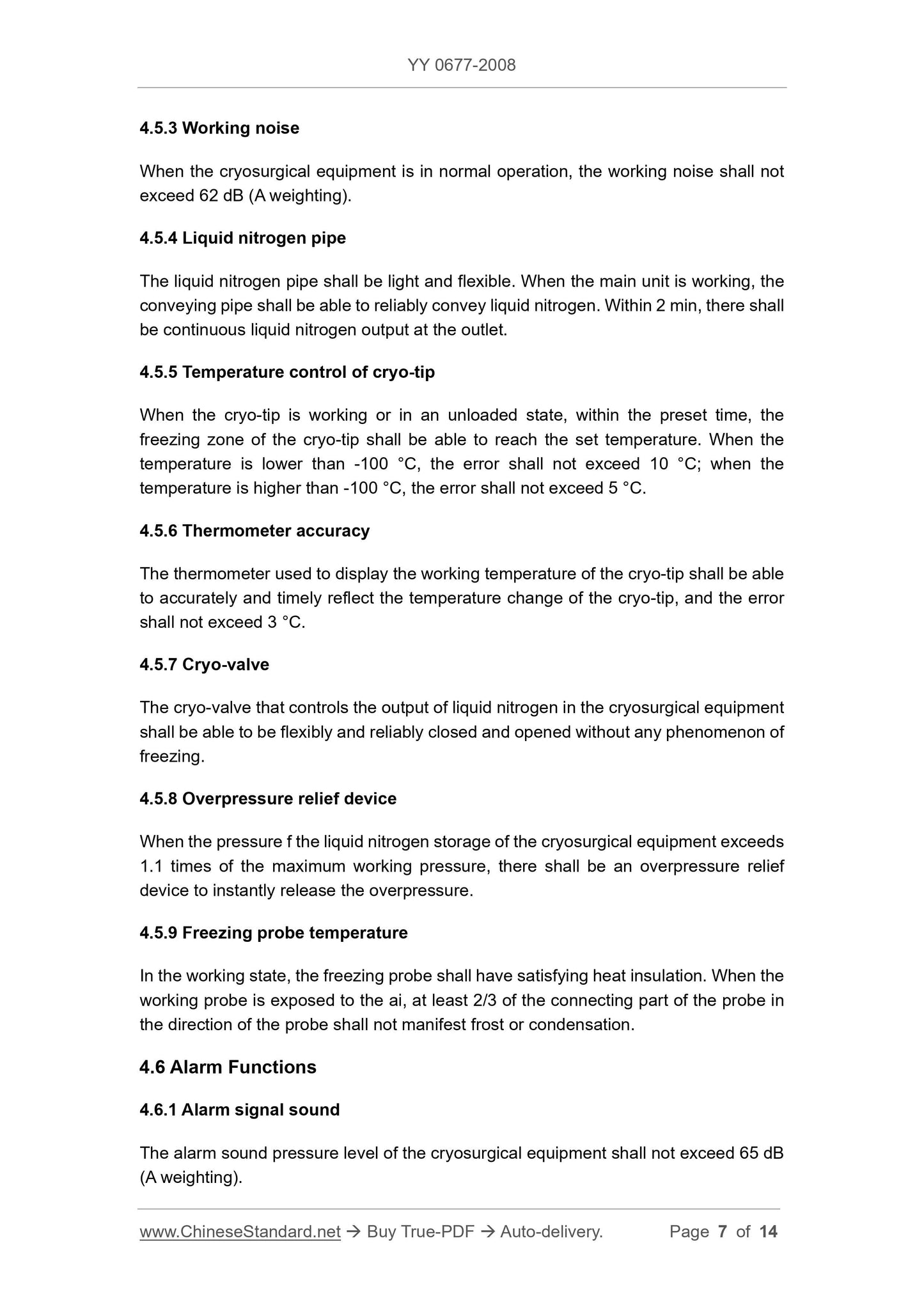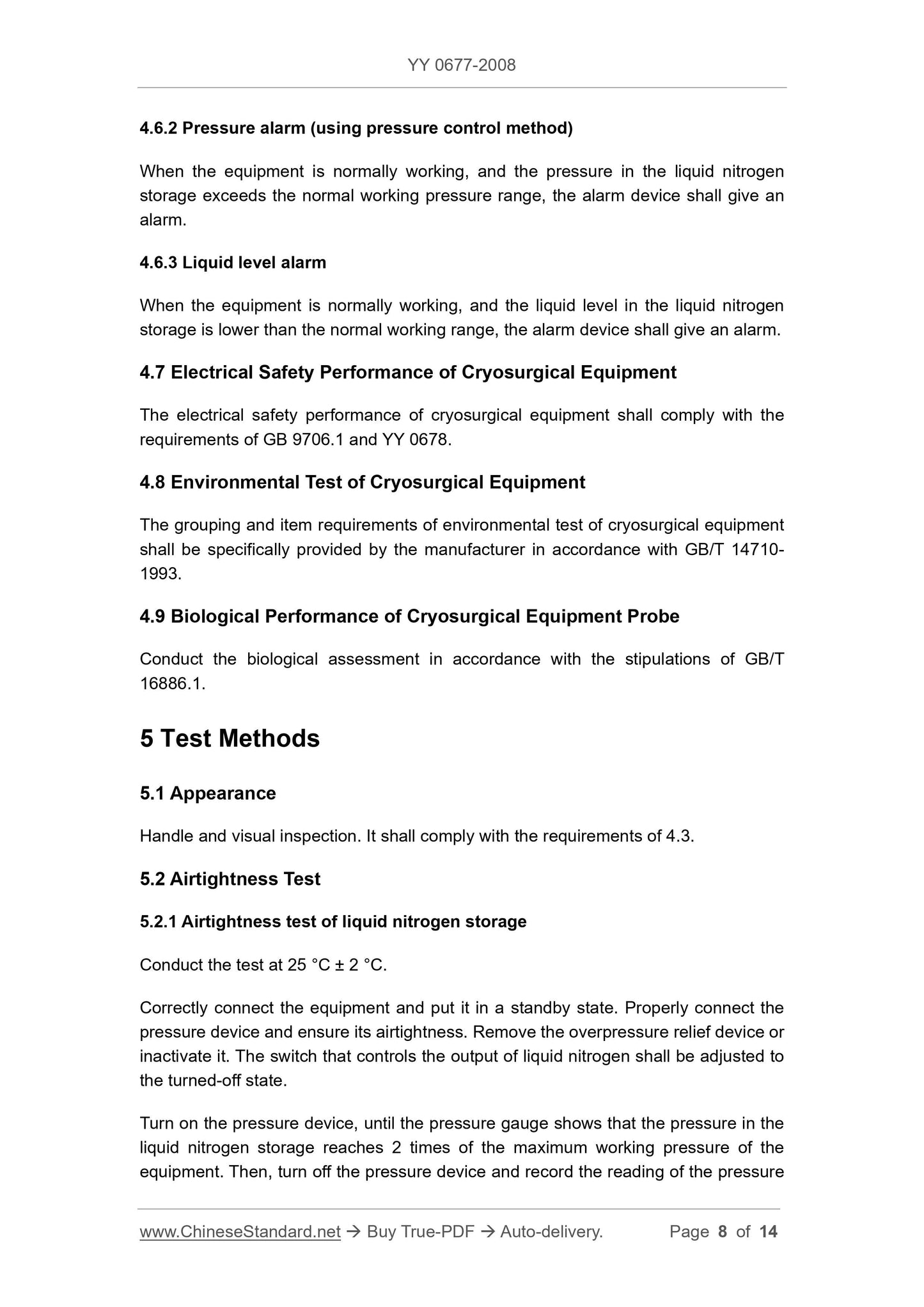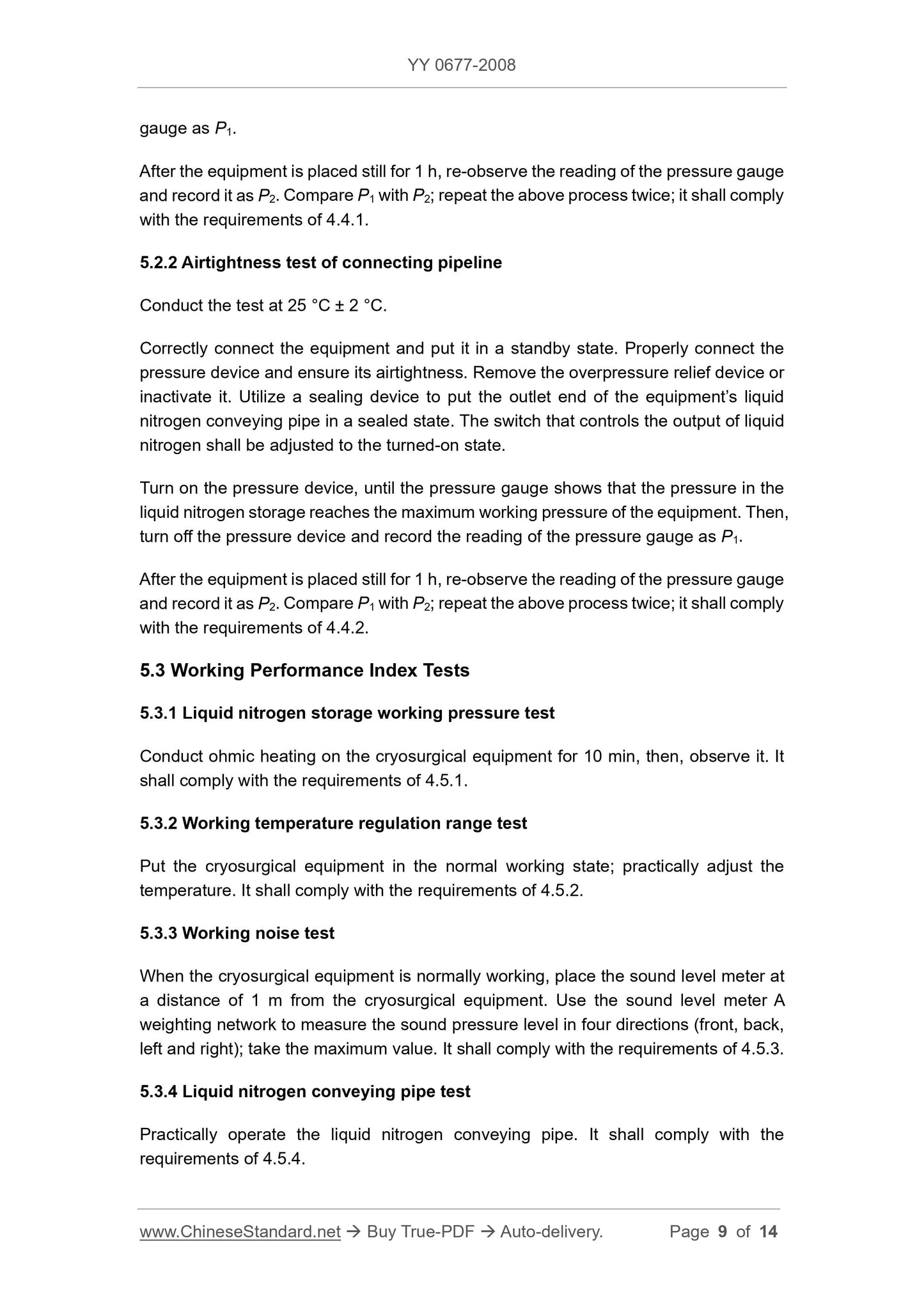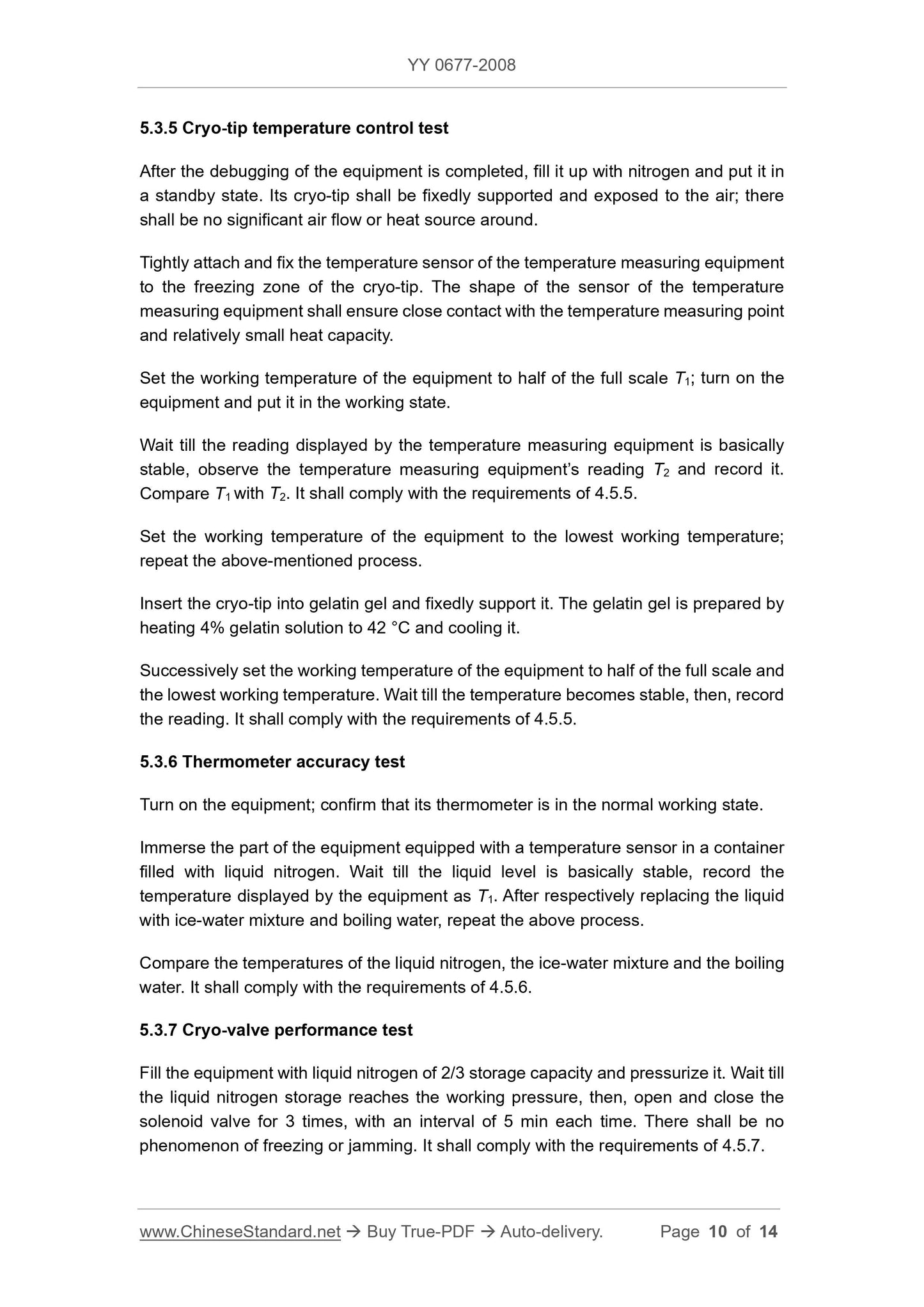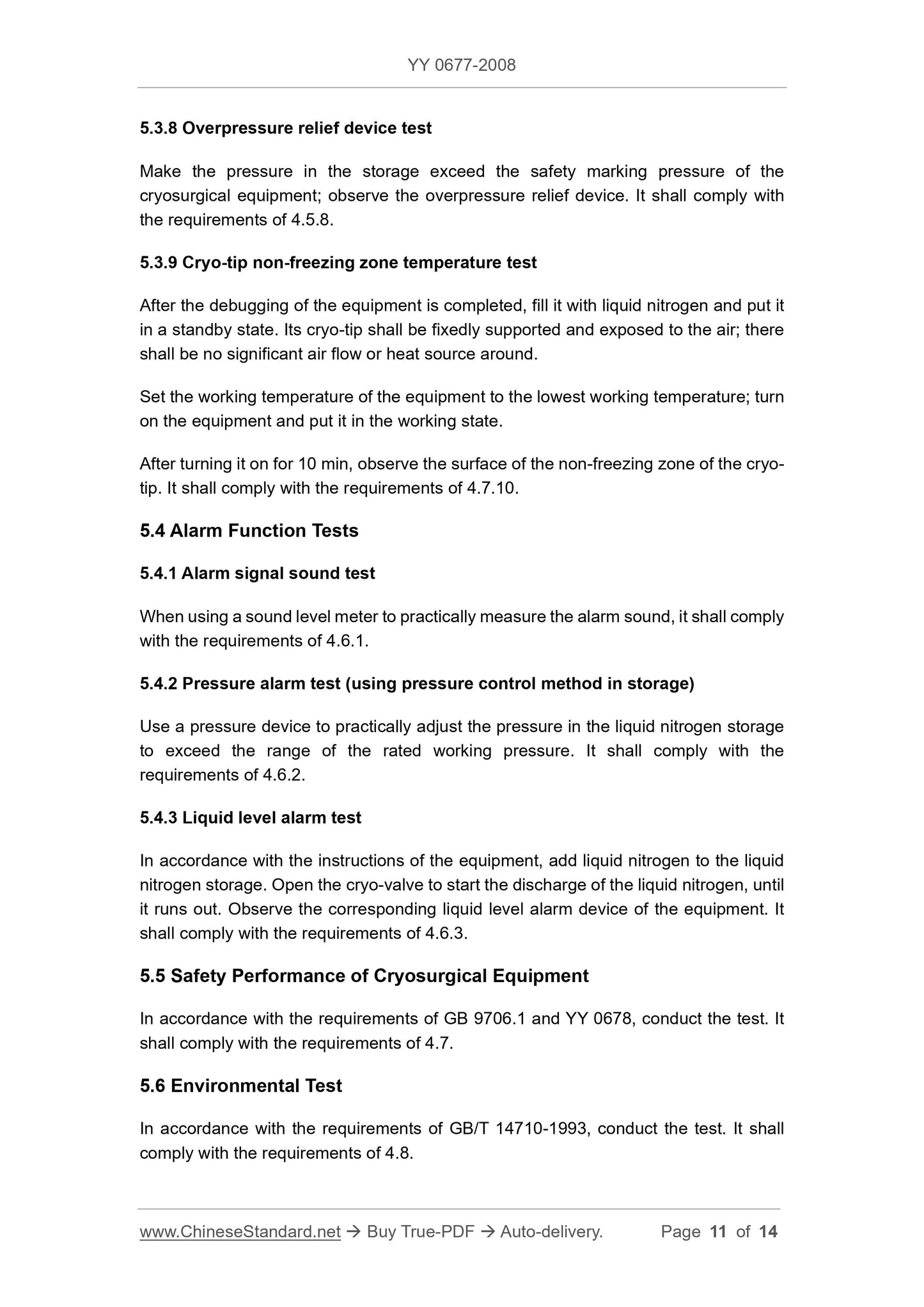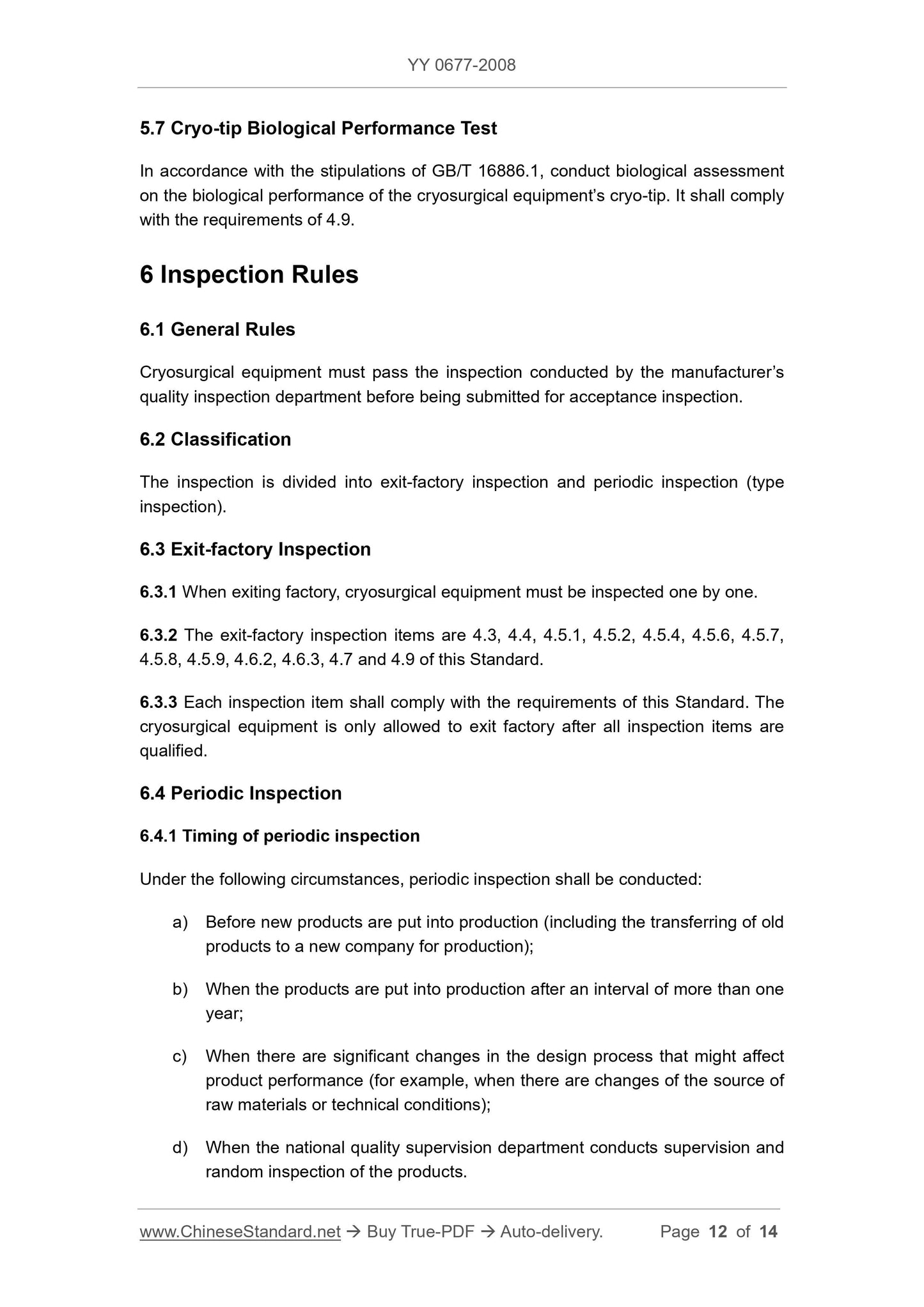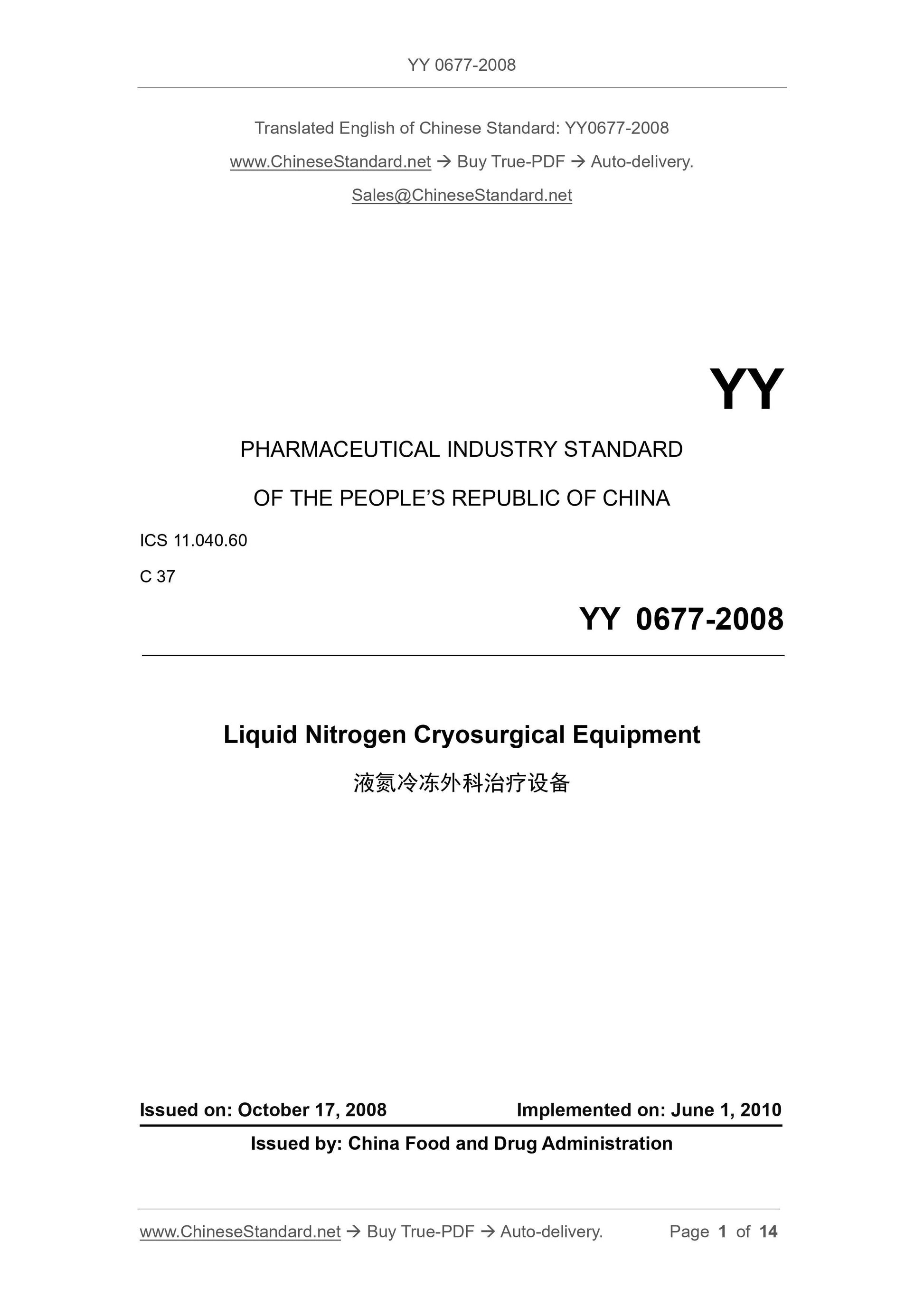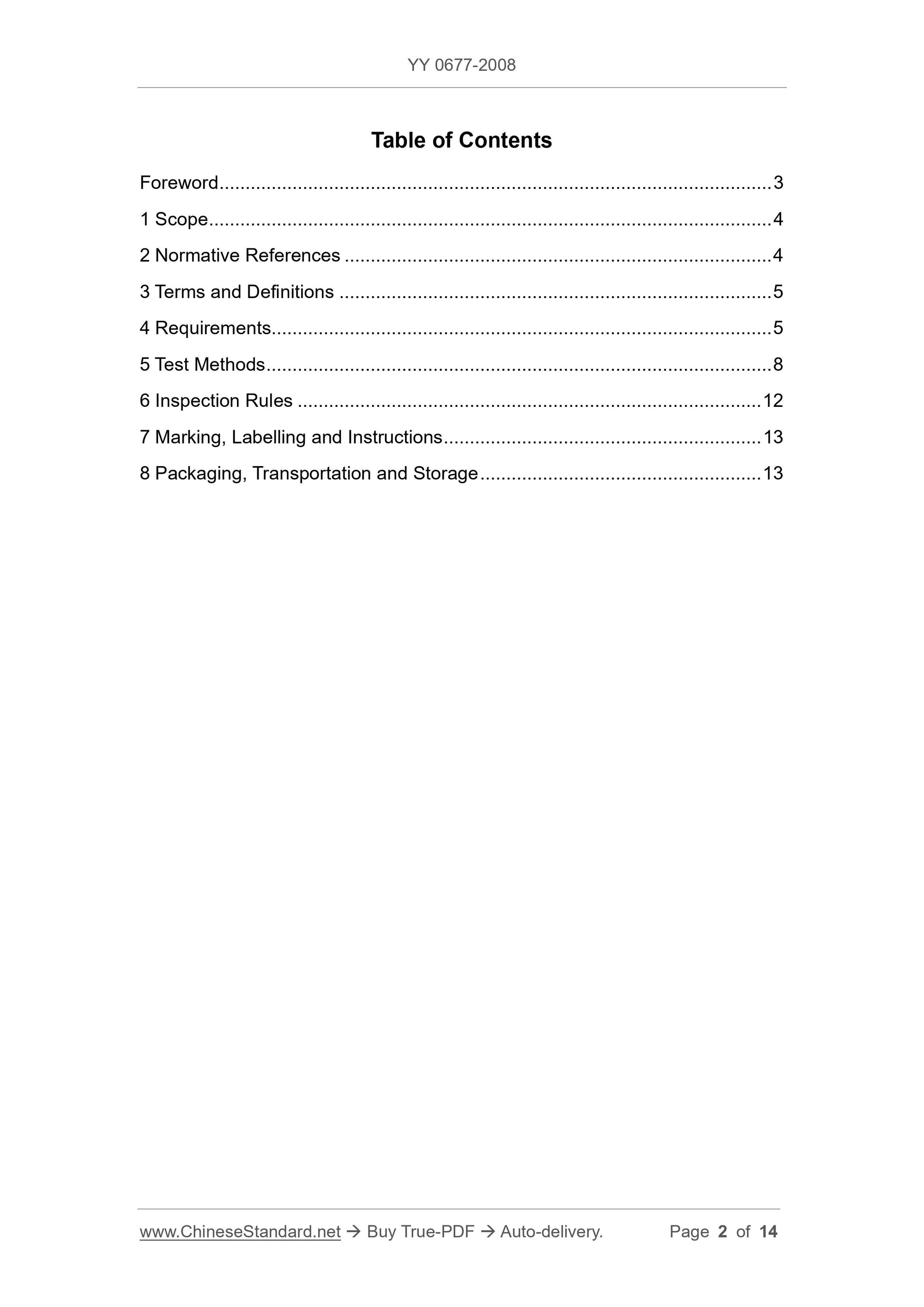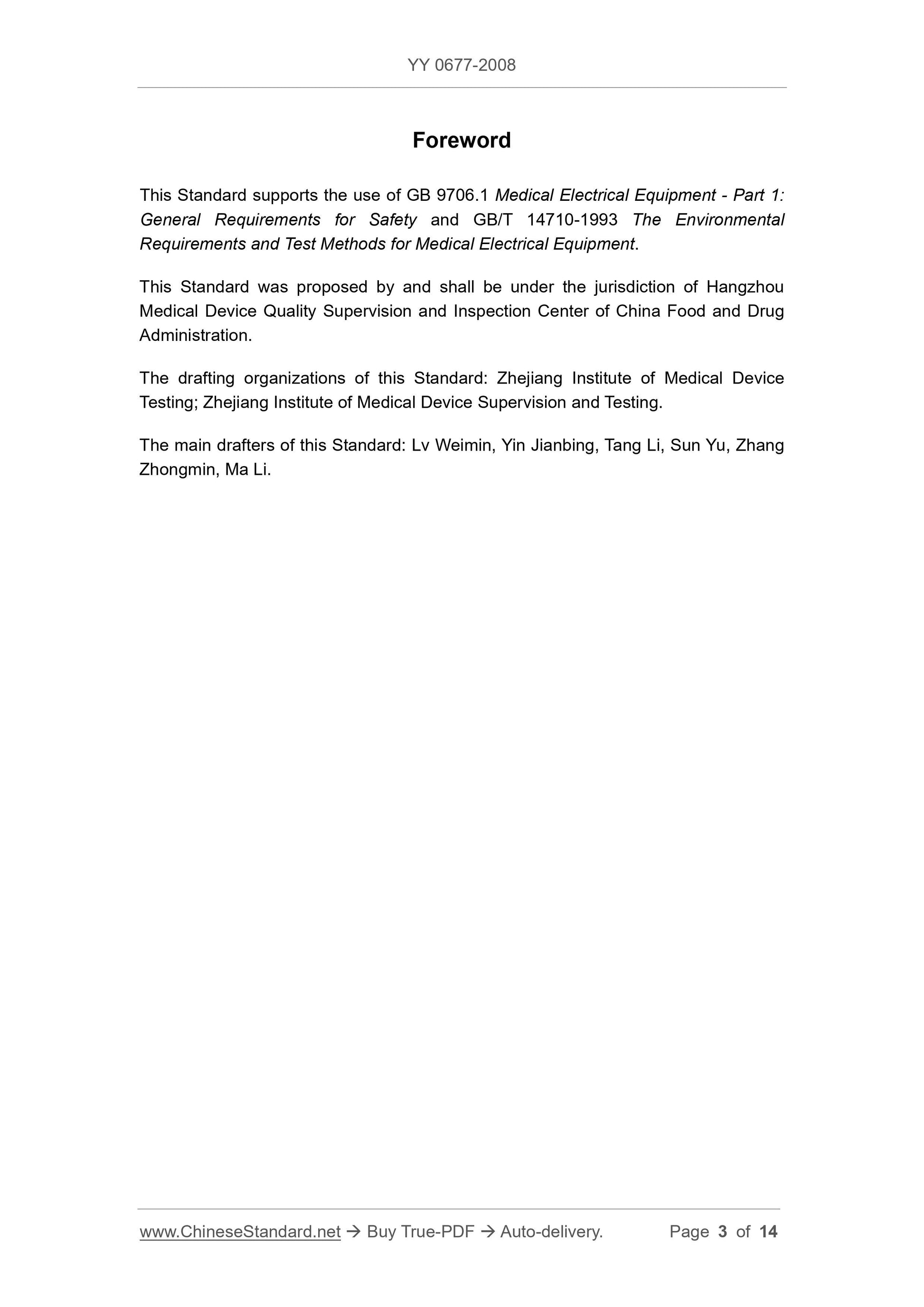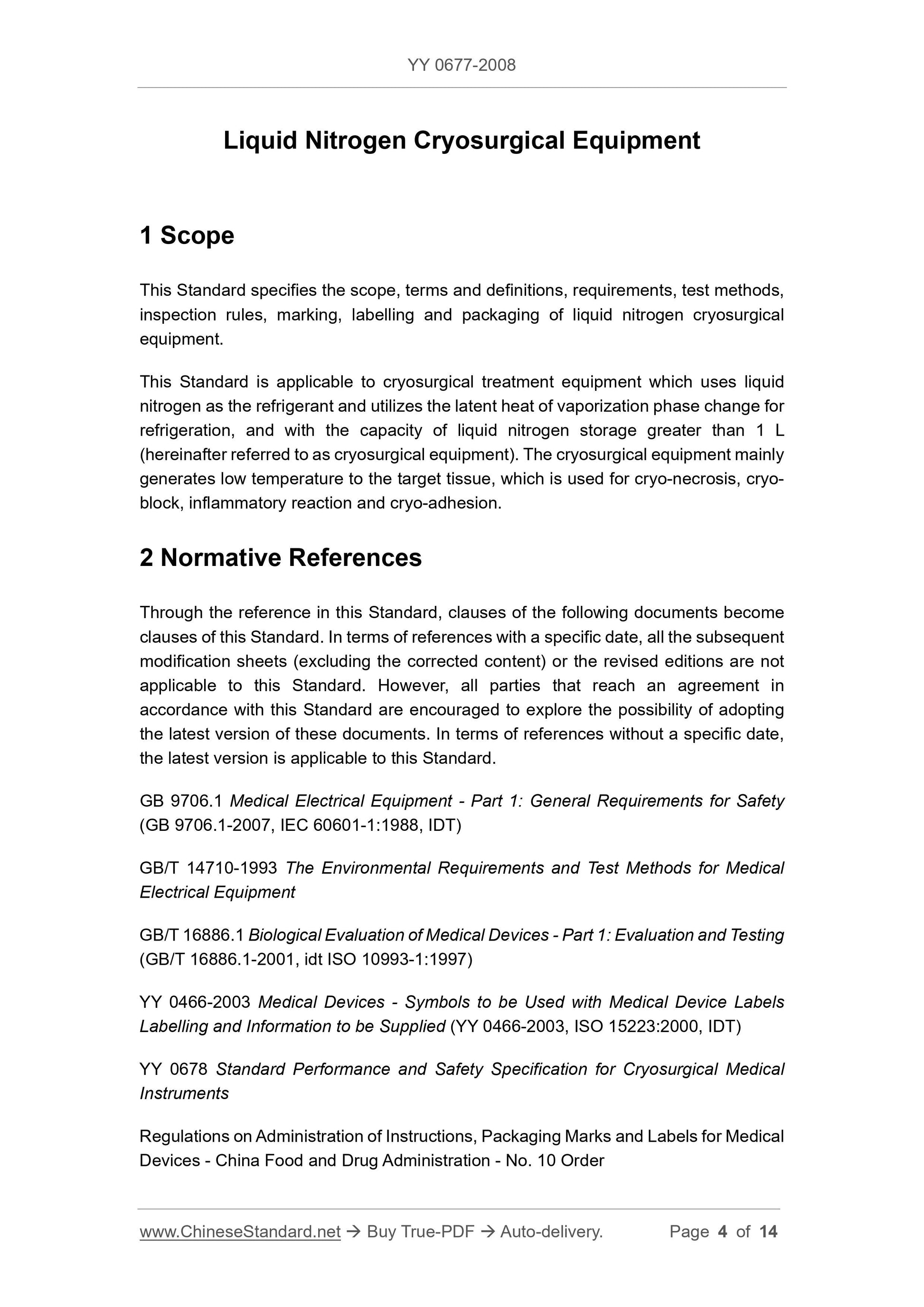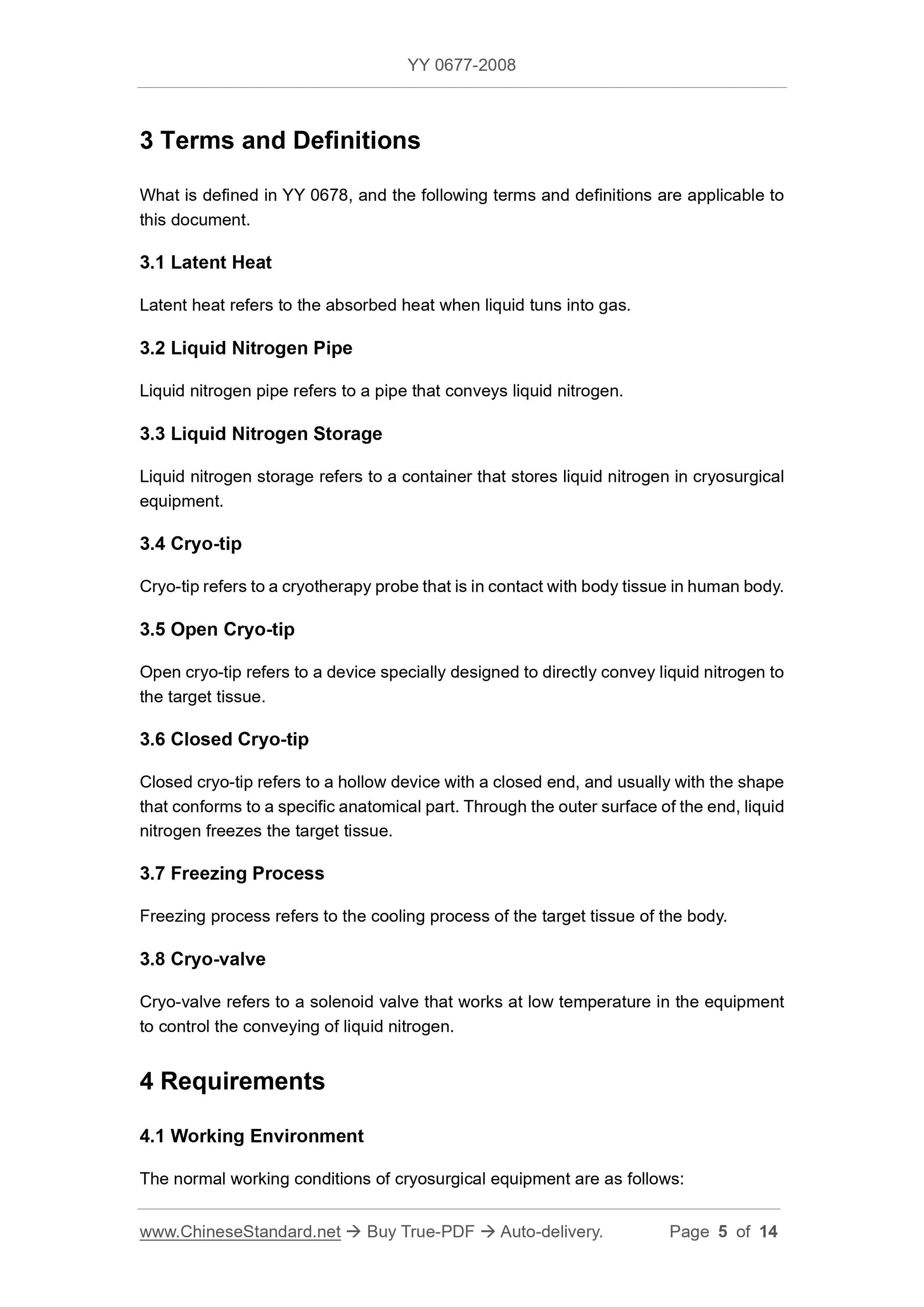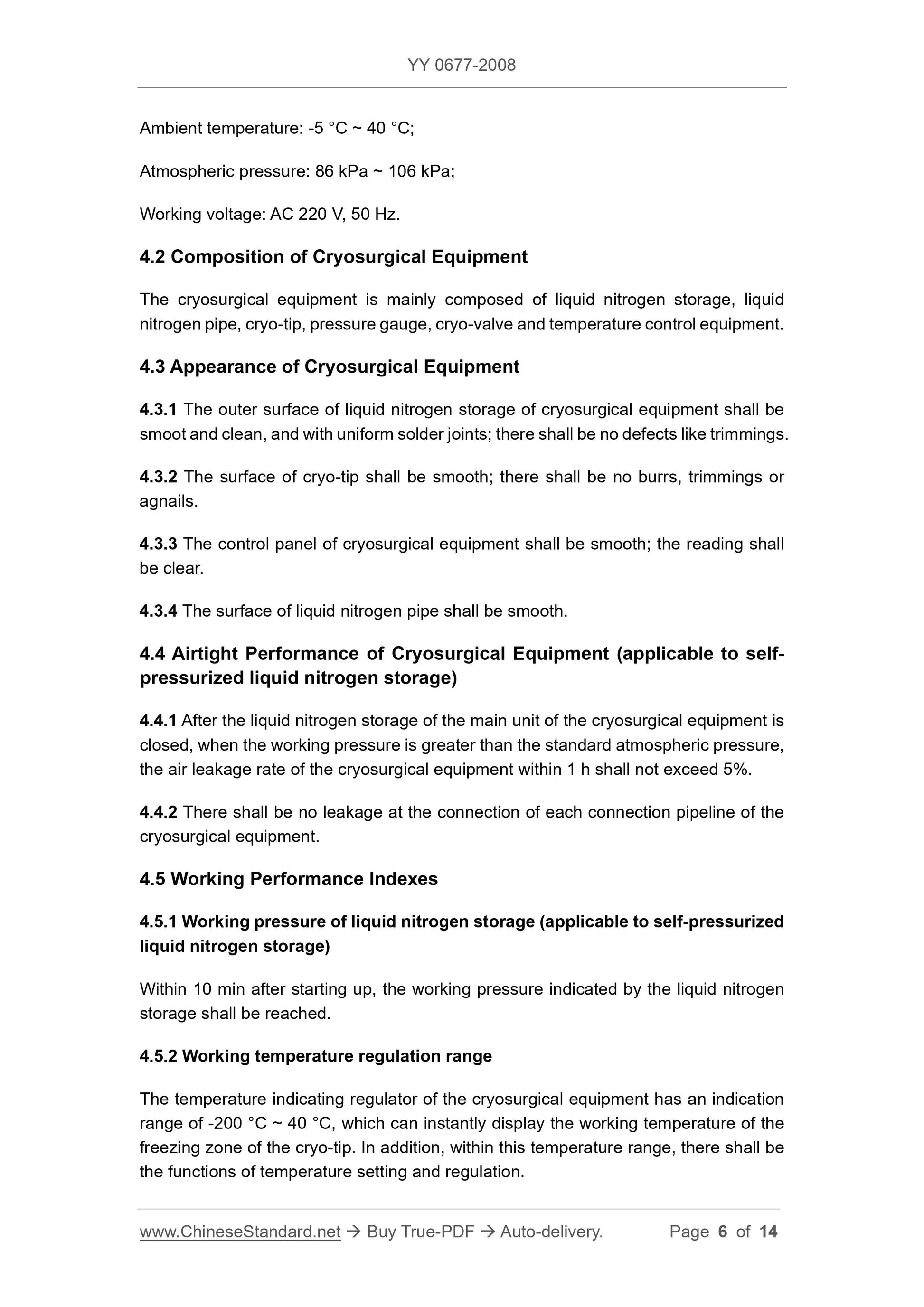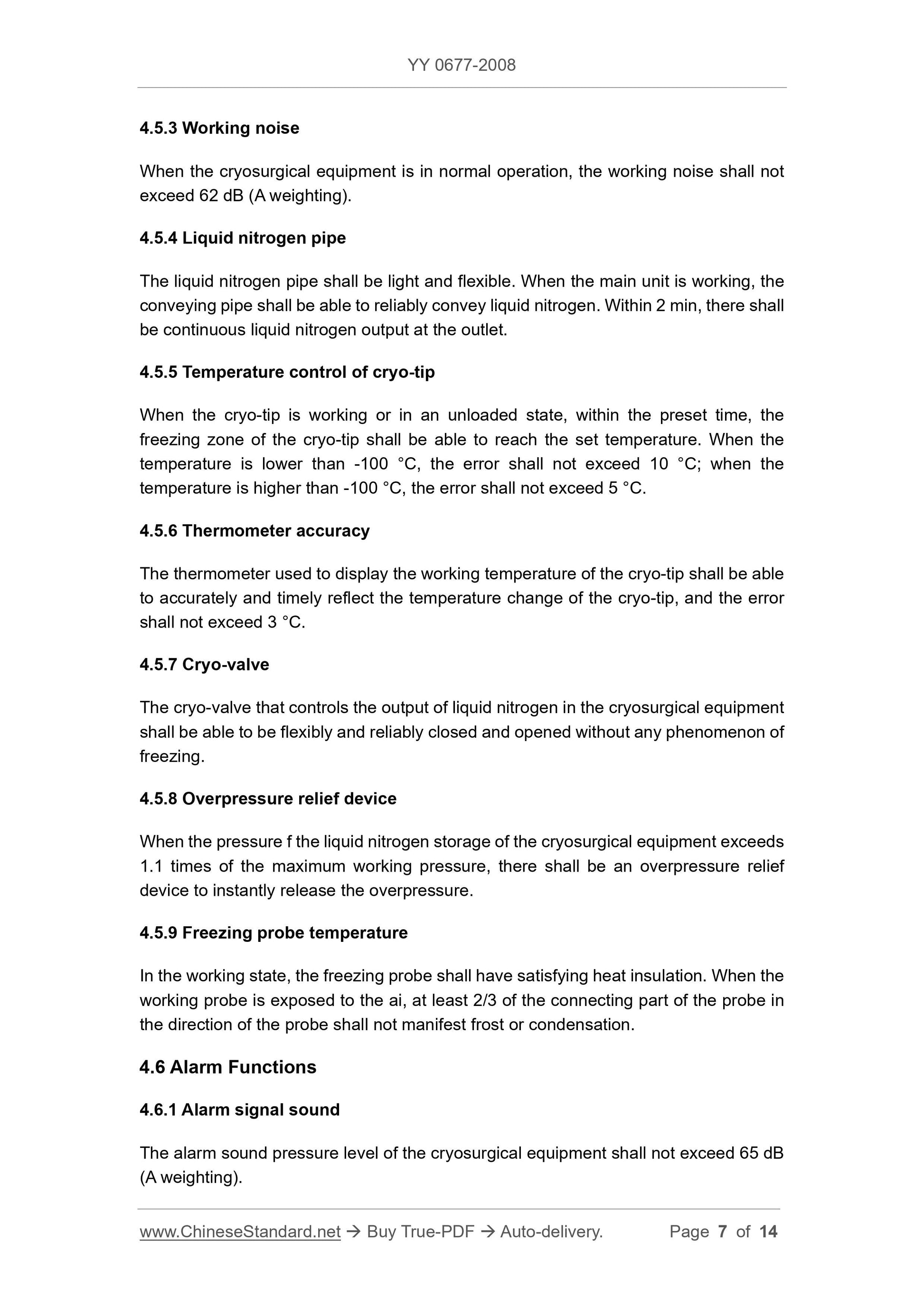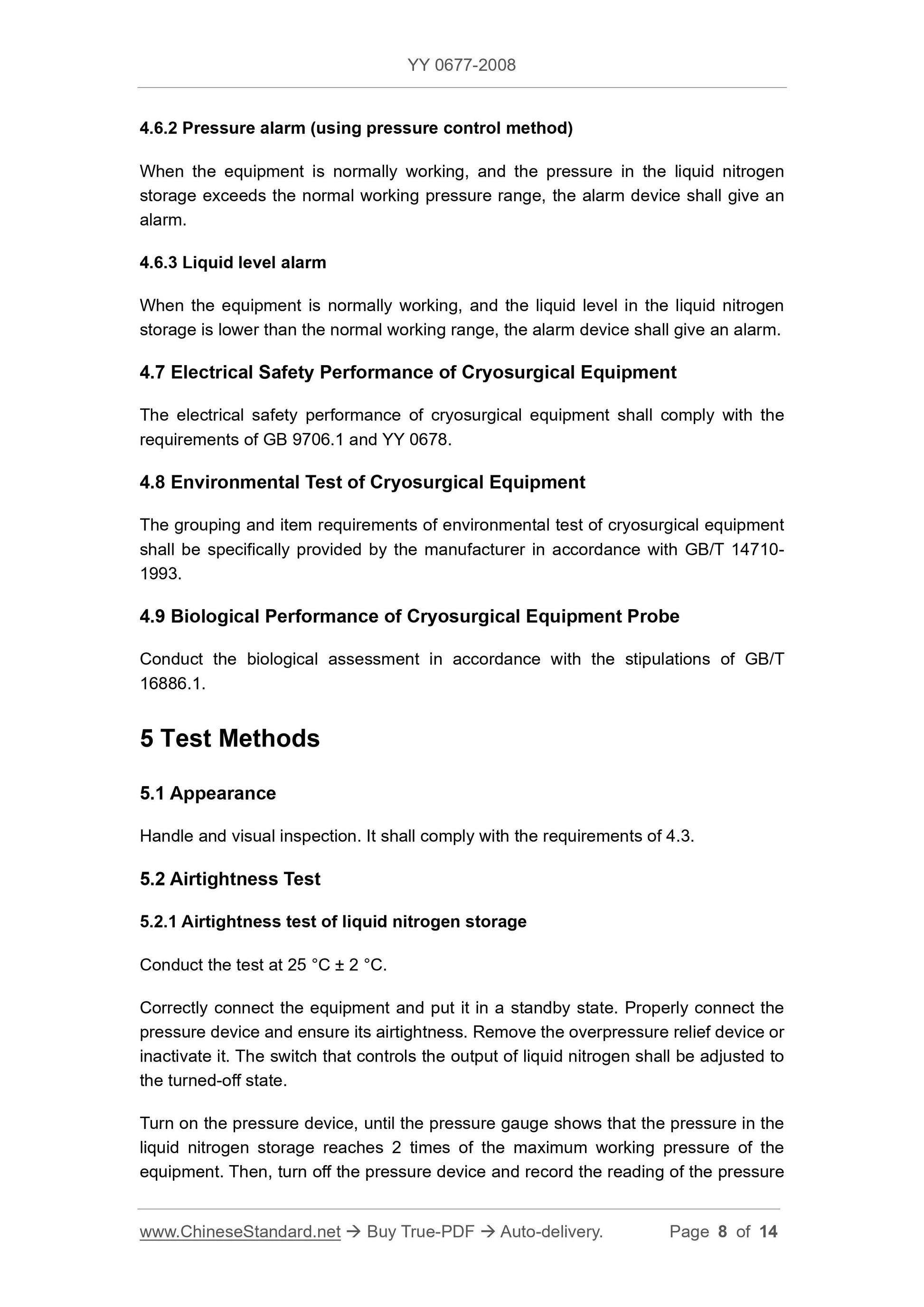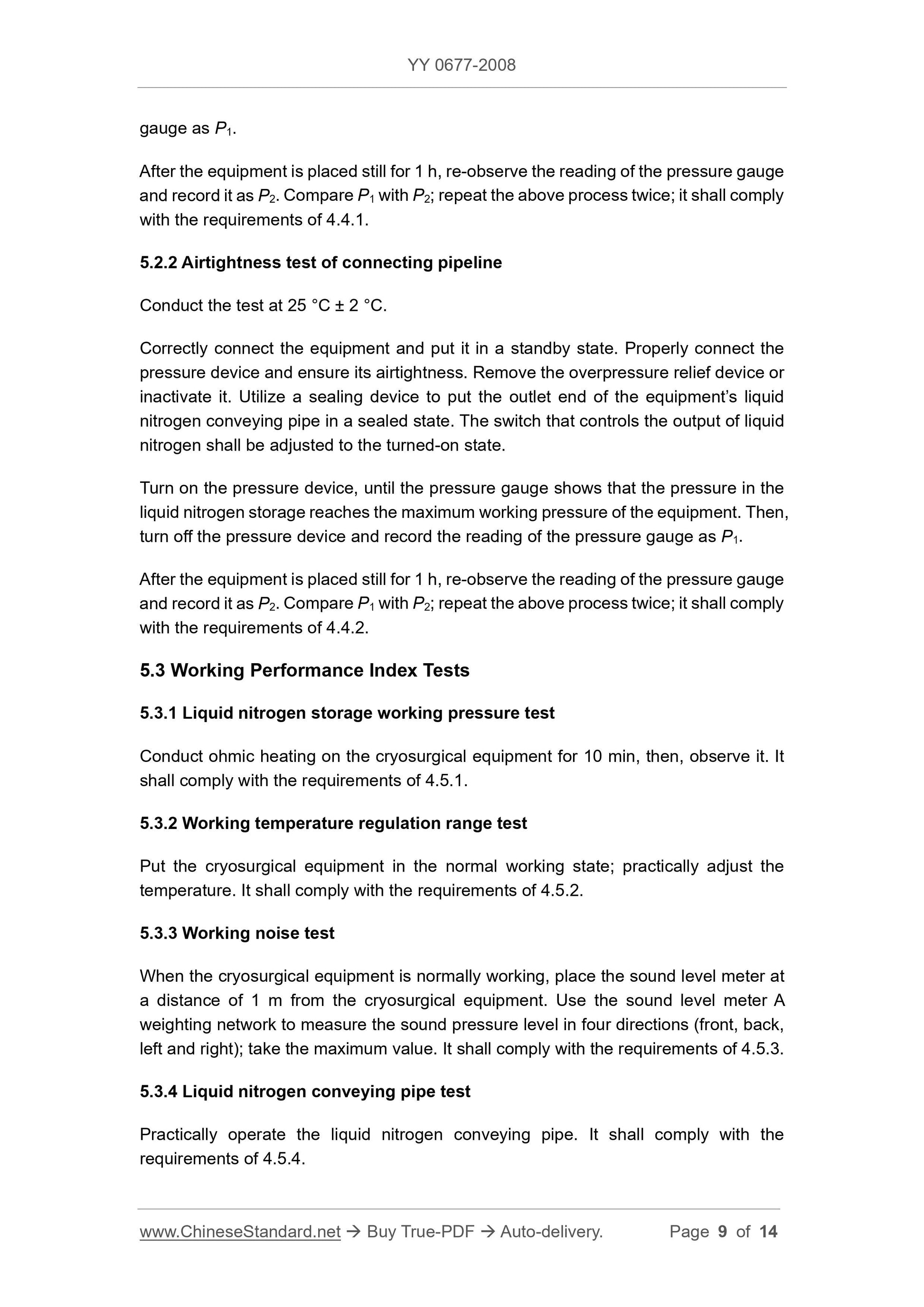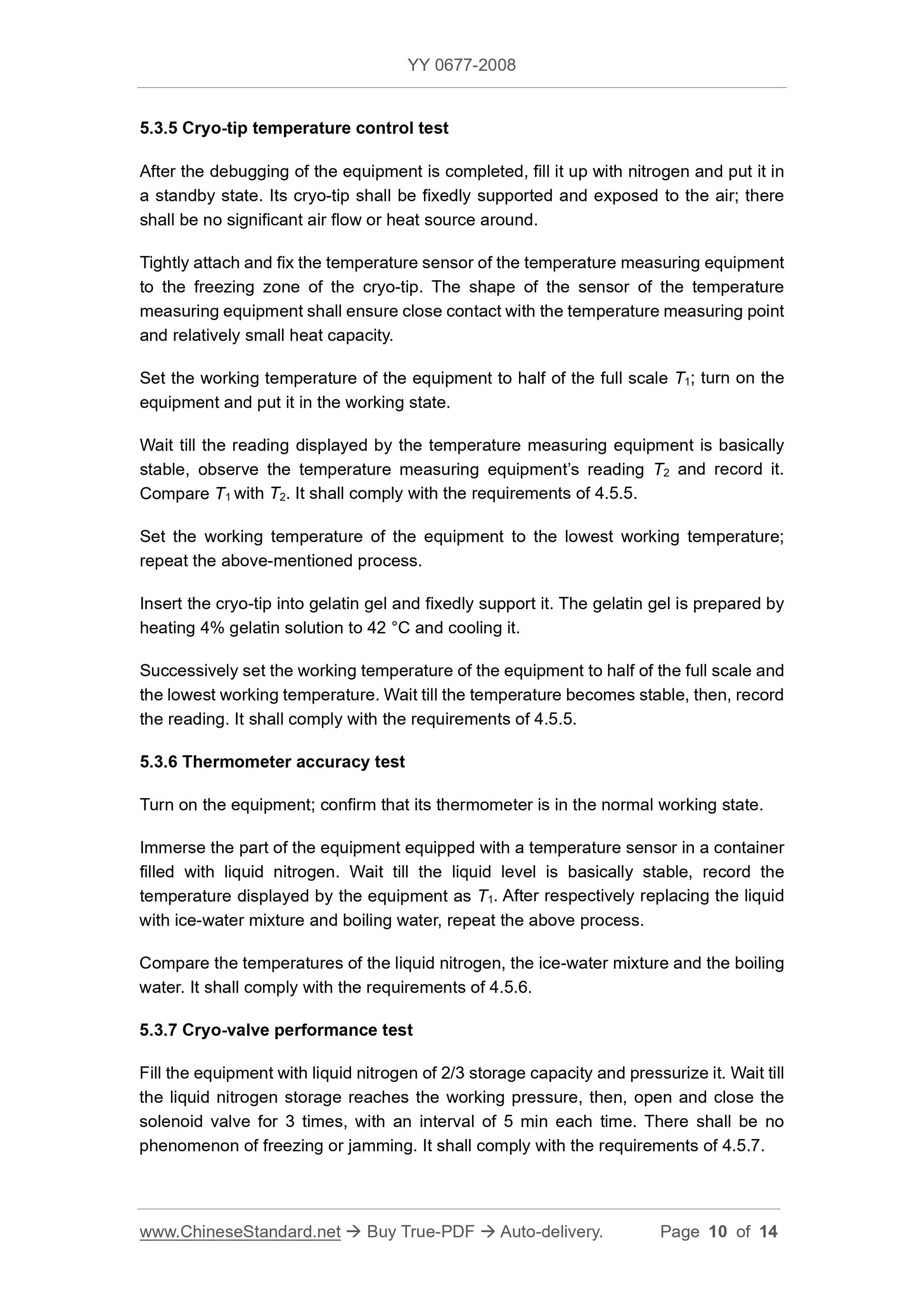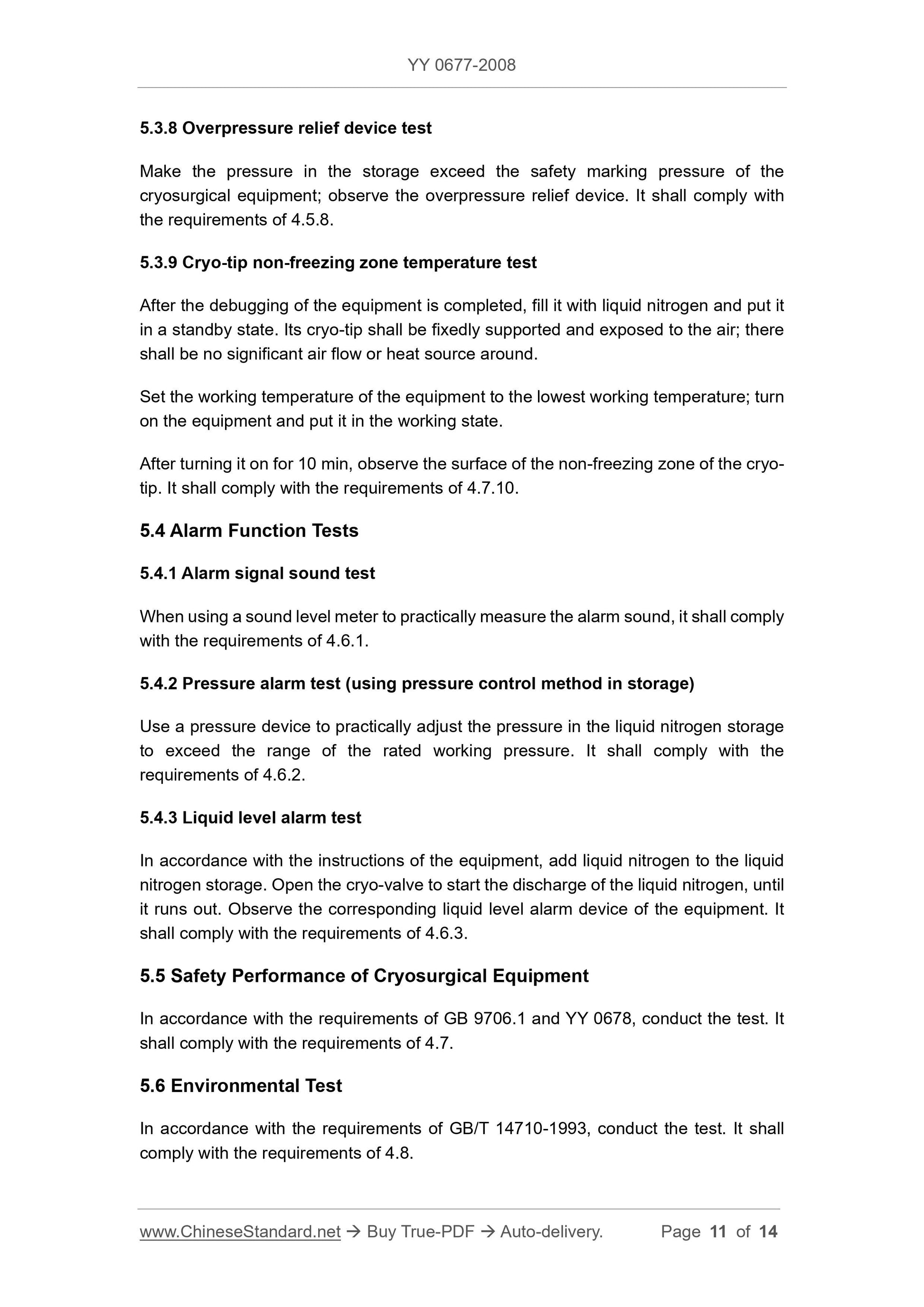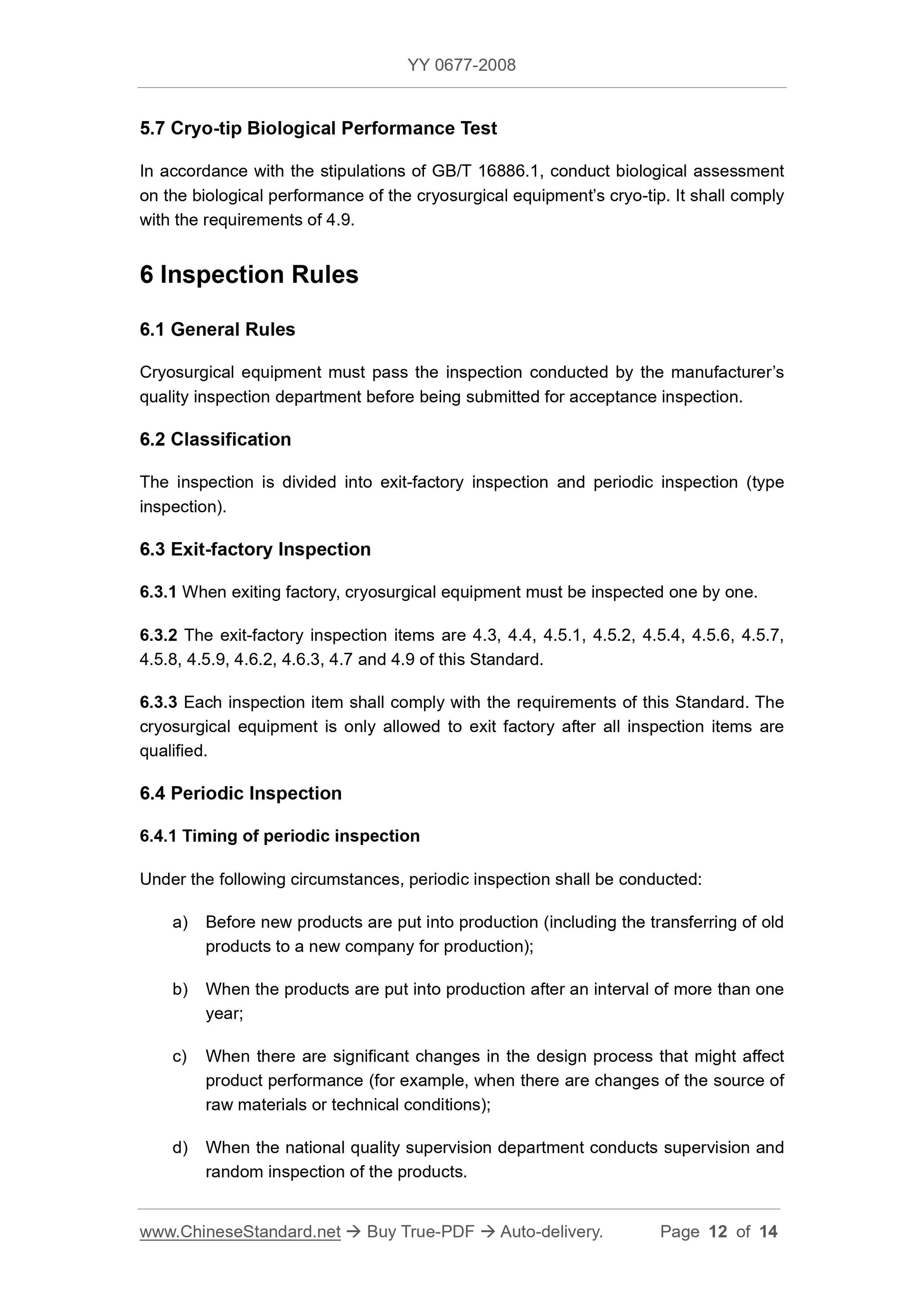1
/
su
12
PayPal, credit cards. Download editable-PDF & invoice in 1 second!
YY 0677-2008 English PDF (YY0677-2008)
YY 0677-2008 English PDF (YY0677-2008)
Prezzo di listino
$170.00 USD
Prezzo di listino
Prezzo scontato
$170.00 USD
Prezzo unitario
/
per
Spese di spedizione calcolate al check-out.
Impossibile caricare la disponibilità di ritiro
Delivery: 3 seconds. Download true-PDF + Invoice.
Get QUOTATION in 1-minute: Click YY 0677-2008
Historical versions: YY 0677-2008
Preview True-PDF (Reload/Scroll if blank)
YY 0677-2008: [YY/T 0677-2008] Liquid nitrogen cryosurgical equipment
YY 0677-2008
YY
PHARMACEUTICAL INDUSTRY STANDARD
OF THE PEOPLE’S REPUBLIC OF CHINA
ICS 11.040.60
C 37
Liquid Nitrogen Cryosurgical Equipment
液氮冷冻外科治疗设备
ISSUED ON: OCTOBER 17, 2008
IMPLEMENTED ON: JUNE 1, 2010
Issued by: China Food and Drug Administration
Table of Contents
Foreword ... 3
1 Scope ... 4
2 Normative References ... 4
3 Terms and Definitions ... 5
4 Requirements... 5
5 Test Methods ... 8
6 Inspection Rules ... 12
7 Marking, Labelling and Instructions ... 13
8 Packaging, Transportation and Storage ... 13
Liquid Nitrogen Cryosurgical Equipment
1 Scope
This Standard specifies the scope, terms and definitions, requirements, test methods,
inspection rules, marking, labelling and packaging of liquid nitrogen cryosurgical
equipment.
This Standard is applicable to cryosurgical treatment equipment which uses liquid
nitrogen as the refrigerant and utilizes the latent heat of vaporization phase change for
refrigeration, and with the capacity of liquid nitrogen storage greater than 1 L
(hereinafter referred to as cryosurgical equipment). The cryosurgical equipment mainly
generates low temperature to the target tissue, which is used for cryo-necrosis, cryo-
block, inflammatory reaction and cryo-adhesion.
2 Normative References
Through the reference in this Standard, clauses of the following documents become
clauses of this Standard. In terms of references with a specific date, all the subsequent
modification sheets (excluding the corrected content) or the revised editions are not
applicable to this Standard. However, all parties that reach an agreement in
accordance with this Standard are encouraged to explore the possibility of adopting
the latest version of these documents. In terms of references without a specific date,
the latest version is applicable to this Standard.
GB 9706.1 Medical Electrical Equipment - Part 1: General Requirements for Safety
(GB 9706.1-2007, IEC 60601-1:1988, IDT)
GB/T 14710-1993 The Environmental Requirements and Test Methods for Medical
Electrical Equipment
GB/T 16886.1 Biological Evaluation of Medical Devices - Part 1: Evaluation and Testing
(GB/T 16886.1-2001, idt ISO 10993-1:1997)
YY 0466-2003 Medical Devices - Symbols to be Used with Medical Device Labels
Labelling and Information to be Supplied (YY 0466-2003, ISO 15223:2000, IDT)
YY 0678 Standard Performance and Safety Specification for Cryosurgical Medical
Instruments
Regulations on Administration of Instructions, Packaging Marks and Labels for Medical
Devices - China Food and Drug Administration - No. 10 Order
Ambient temperature: -5 °C ~ 40 °C;
Atmospheric pressure: 86 kPa ~ 106 kPa;
Working voltage: AC 220 V, 50 Hz.
4.2 Composition of Cryosurgical Equipment
The cryosurgical equipment is mainly composed of liquid nitrogen storage, liquid
nitrogen pipe, cryo-tip, pressure gauge, cryo-valve and temperature control equipment.
4.3 Appearance of Cryosurgical Equipment
4.3.1 The outer surface of liquid nitrogen storage of cryosurgical equipment shall be
smoot and clean, and with uniform solder joints; there shall be no defects like trimmings.
4.3.2 The surface of cryo-tip shall be smooth; there shall be no burrs, trimmings or
agnails.
4.3.3 The control panel of cryosurgical equipment shall be smooth; the reading shall
be clear.
4.3.4 The surface of liquid nitrogen pipe shall be smooth.
4.4 Airtight Performance of Cryosurgical Equipment (applicable to self-
pressurized liquid nitrogen storage)
4.4.1 After the liquid nitrogen storage of the main unit of the cryosurgical equipment is
closed, when the working pressure is greater than the standard atmospheric pressure,
the air leakage rate of the cryosurgical equipment within 1 h shall not exceed 5%.
4.4.2 There shall be no leakage at the connection of each connection pipeline of the
cryosurgical equipment.
4.5 Working Performance Indexes
4.5.1 Working pressure of liquid nitrogen storage (applicable to self-pressurized
liquid nitrogen storage)
Within 10 min after starting up, the working pressure indicated by the liquid nitrogen
storage shall be reached.
4.5.2 Working temperature regulation range
The temperature indicating regulator of the cryosurgical equipment has an indication
range of -200 °C ~ 40 °C, which can instantly display the working temperature of the
freezing zone of the cryo-tip. In addition, within this temperature range, there shall be
the functions of temperature setting and regulation.
4.6.2 Pressure alarm (using pressure control method)
When the equipment is normally working, and the pressure in the liquid nitrogen
storage exceeds the normal working pressure range, the alarm device shall give an
alarm.
4.6.3 Liquid level alarm
When the equipment is normally working, and the liquid level in the liquid nitrogen
storage is lower than the normal working range, the alarm device shall give an alarm.
4.7 Electrical Safety Performance of Cryosurgical Equipment
The electrical safety performance of cryosurgical equipment shall comply with the
requirements of GB 9706.1 and YY 0678.
4.8 Environmental Test of Cryosurgical Equipment
The grouping and item requirements of environmental test of cryosurgical equipment
shall be specifically provided by the manufacturer in accordance with GB/T 14710-
1993.
4.9 Biological Performance of Cryosurgical Equipment Probe
Conduct the biological assessment in accordance with the stipulations of GB/T
16886.1.
5 Test Methods
5.1 Appearance
Handle and visual inspection. It shall comply with the requirements of 4.3.
5.2 Airtightness Test
5.2.1 Airtightness test of liquid nitrogen storage
Conduct the test at 25 °C ± 2 °C.
Correctly connect the equipment and put it in a standby state. Properly connect the
pressure device and ensure its airtightness. Remove the overpressure relief device or
inactivate it. The switch that controls the output of liquid nitrogen shall be adjusted to
the turned-off state.
Turn on the pressure device, until the pressure gauge shows that the pressure in the
liquid nitrogen storage reaches 2 times of the maximum working pressure of the
equipment. Then, turn off the pressure device and record the reading of the pressure
5.3.5 Cryo-tip temperature control test
After the debugging of the equipment is completed, fill it up with nitrogen and put it in
a standby state. Its cryo-tip shall be fixedly supported and exposed to the air; there
shall be no significant air flow or heat source around.
Tightly attach and fix the temperature sensor of the temperature measuring equipment
to the freezing zone of the cryo-tip. The shape of the sensor of the temperature
measuring equipment shall ensure close contact with the temperature measuring point
and relatively small heat capacity.
Set the working temperature of the equipment to half of the full scale T1; turn on the
equipment and put it in the working state.
Wait till the reading displayed by the temperature measuring equipment is basically
stable, observe the temperature measuring equipment’s reading T2 and record it.
Compare T1 with T2. It shall comply with the requirements of 4.5.5.
Set the working temperature of the equipment to the lowest working temperature;
repeat the above-mentioned process.
Insert the cryo-tip into gelatin gel and fixedly support it. The gelatin gel is prepared by
heating 4% gelatin solution to 42 °C and cooling it.
Successively set the working temperature...
Get QUOTATION in 1-minute: Click YY 0677-2008
Historical versions: YY 0677-2008
Preview True-PDF (Reload/Scroll if blank)
YY 0677-2008: [YY/T 0677-2008] Liquid nitrogen cryosurgical equipment
YY 0677-2008
YY
PHARMACEUTICAL INDUSTRY STANDARD
OF THE PEOPLE’S REPUBLIC OF CHINA
ICS 11.040.60
C 37
Liquid Nitrogen Cryosurgical Equipment
液氮冷冻外科治疗设备
ISSUED ON: OCTOBER 17, 2008
IMPLEMENTED ON: JUNE 1, 2010
Issued by: China Food and Drug Administration
Table of Contents
Foreword ... 3
1 Scope ... 4
2 Normative References ... 4
3 Terms and Definitions ... 5
4 Requirements... 5
5 Test Methods ... 8
6 Inspection Rules ... 12
7 Marking, Labelling and Instructions ... 13
8 Packaging, Transportation and Storage ... 13
Liquid Nitrogen Cryosurgical Equipment
1 Scope
This Standard specifies the scope, terms and definitions, requirements, test methods,
inspection rules, marking, labelling and packaging of liquid nitrogen cryosurgical
equipment.
This Standard is applicable to cryosurgical treatment equipment which uses liquid
nitrogen as the refrigerant and utilizes the latent heat of vaporization phase change for
refrigeration, and with the capacity of liquid nitrogen storage greater than 1 L
(hereinafter referred to as cryosurgical equipment). The cryosurgical equipment mainly
generates low temperature to the target tissue, which is used for cryo-necrosis, cryo-
block, inflammatory reaction and cryo-adhesion.
2 Normative References
Through the reference in this Standard, clauses of the following documents become
clauses of this Standard. In terms of references with a specific date, all the subsequent
modification sheets (excluding the corrected content) or the revised editions are not
applicable to this Standard. However, all parties that reach an agreement in
accordance with this Standard are encouraged to explore the possibility of adopting
the latest version of these documents. In terms of references without a specific date,
the latest version is applicable to this Standard.
GB 9706.1 Medical Electrical Equipment - Part 1: General Requirements for Safety
(GB 9706.1-2007, IEC 60601-1:1988, IDT)
GB/T 14710-1993 The Environmental Requirements and Test Methods for Medical
Electrical Equipment
GB/T 16886.1 Biological Evaluation of Medical Devices - Part 1: Evaluation and Testing
(GB/T 16886.1-2001, idt ISO 10993-1:1997)
YY 0466-2003 Medical Devices - Symbols to be Used with Medical Device Labels
Labelling and Information to be Supplied (YY 0466-2003, ISO 15223:2000, IDT)
YY 0678 Standard Performance and Safety Specification for Cryosurgical Medical
Instruments
Regulations on Administration of Instructions, Packaging Marks and Labels for Medical
Devices - China Food and Drug Administration - No. 10 Order
Ambient temperature: -5 °C ~ 40 °C;
Atmospheric pressure: 86 kPa ~ 106 kPa;
Working voltage: AC 220 V, 50 Hz.
4.2 Composition of Cryosurgical Equipment
The cryosurgical equipment is mainly composed of liquid nitrogen storage, liquid
nitrogen pipe, cryo-tip, pressure gauge, cryo-valve and temperature control equipment.
4.3 Appearance of Cryosurgical Equipment
4.3.1 The outer surface of liquid nitrogen storage of cryosurgical equipment shall be
smoot and clean, and with uniform solder joints; there shall be no defects like trimmings.
4.3.2 The surface of cryo-tip shall be smooth; there shall be no burrs, trimmings or
agnails.
4.3.3 The control panel of cryosurgical equipment shall be smooth; the reading shall
be clear.
4.3.4 The surface of liquid nitrogen pipe shall be smooth.
4.4 Airtight Performance of Cryosurgical Equipment (applicable to self-
pressurized liquid nitrogen storage)
4.4.1 After the liquid nitrogen storage of the main unit of the cryosurgical equipment is
closed, when the working pressure is greater than the standard atmospheric pressure,
the air leakage rate of the cryosurgical equipment within 1 h shall not exceed 5%.
4.4.2 There shall be no leakage at the connection of each connection pipeline of the
cryosurgical equipment.
4.5 Working Performance Indexes
4.5.1 Working pressure of liquid nitrogen storage (applicable to self-pressurized
liquid nitrogen storage)
Within 10 min after starting up, the working pressure indicated by the liquid nitrogen
storage shall be reached.
4.5.2 Working temperature regulation range
The temperature indicating regulator of the cryosurgical equipment has an indication
range of -200 °C ~ 40 °C, which can instantly display the working temperature of the
freezing zone of the cryo-tip. In addition, within this temperature range, there shall be
the functions of temperature setting and regulation.
4.6.2 Pressure alarm (using pressure control method)
When the equipment is normally working, and the pressure in the liquid nitrogen
storage exceeds the normal working pressure range, the alarm device shall give an
alarm.
4.6.3 Liquid level alarm
When the equipment is normally working, and the liquid level in the liquid nitrogen
storage is lower than the normal working range, the alarm device shall give an alarm.
4.7 Electrical Safety Performance of Cryosurgical Equipment
The electrical safety performance of cryosurgical equipment shall comply with the
requirements of GB 9706.1 and YY 0678.
4.8 Environmental Test of Cryosurgical Equipment
The grouping and item requirements of environmental test of cryosurgical equipment
shall be specifically provided by the manufacturer in accordance with GB/T 14710-
1993.
4.9 Biological Performance of Cryosurgical Equipment Probe
Conduct the biological assessment in accordance with the stipulations of GB/T
16886.1.
5 Test Methods
5.1 Appearance
Handle and visual inspection. It shall comply with the requirements of 4.3.
5.2 Airtightness Test
5.2.1 Airtightness test of liquid nitrogen storage
Conduct the test at 25 °C ± 2 °C.
Correctly connect the equipment and put it in a standby state. Properly connect the
pressure device and ensure its airtightness. Remove the overpressure relief device or
inactivate it. The switch that controls the output of liquid nitrogen shall be adjusted to
the turned-off state.
Turn on the pressure device, until the pressure gauge shows that the pressure in the
liquid nitrogen storage reaches 2 times of the maximum working pressure of the
equipment. Then, turn off the pressure device and record the reading of the pressure
5.3.5 Cryo-tip temperature control test
After the debugging of the equipment is completed, fill it up with nitrogen and put it in
a standby state. Its cryo-tip shall be fixedly supported and exposed to the air; there
shall be no significant air flow or heat source around.
Tightly attach and fix the temperature sensor of the temperature measuring equipment
to the freezing zone of the cryo-tip. The shape of the sensor of the temperature
measuring equipment shall ensure close contact with the temperature measuring point
and relatively small heat capacity.
Set the working temperature of the equipment to half of the full scale T1; turn on the
equipment and put it in the working state.
Wait till the reading displayed by the temperature measuring equipment is basically
stable, observe the temperature measuring equipment’s reading T2 and record it.
Compare T1 with T2. It shall comply with the requirements of 4.5.5.
Set the working temperature of the equipment to the lowest working temperature;
repeat the above-mentioned process.
Insert the cryo-tip into gelatin gel and fixedly support it. The gelatin gel is prepared by
heating 4% gelatin solution to 42 °C and cooling it.
Successively set the working temperature...
Share
